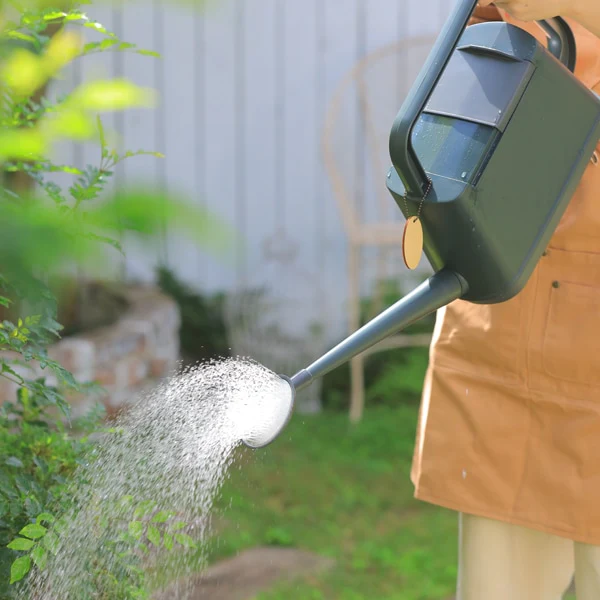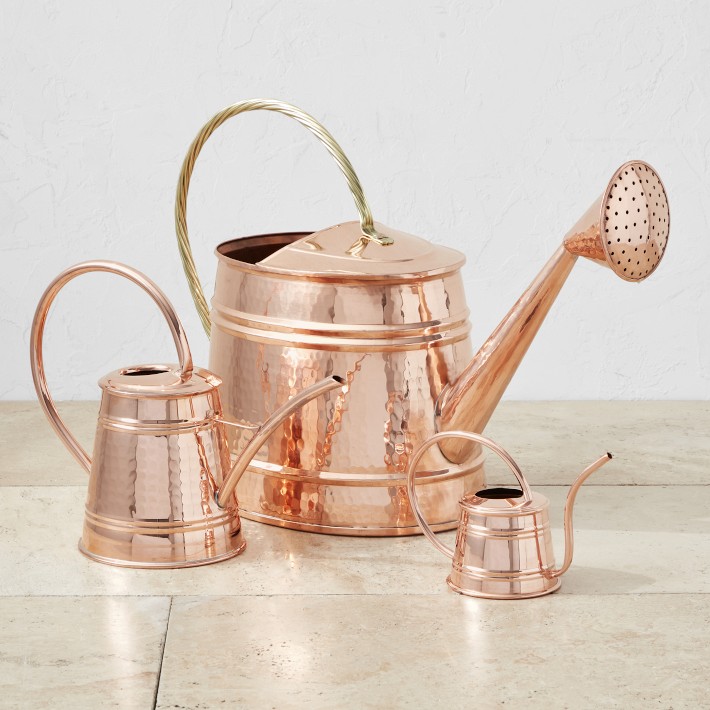
Japanese Watering Can: The Elegant Beauty Meets Functionality
The Art and Craftsmanship of Japanese Watering Cans
The Japanese watering can reflects a tradition of fine craftsmanship. Makers craft each can with care, ensuring not only beauty but also functionality. These watering cans often come from areas known for metalwork. Craftsmen use skills passed down through generations. They shape each piece with precision. Fine materials, like copper and brass, add to their elegance.
The making of a Japanese watering can is an art. Designers consider both form and function. They add details that make the cans not just tools, but also works of art. For instance, the spout design is a key aesthetic feature. The spouts are long and slender, allowing for a gentle flow of water. This design suits tender plants and seedlings well.
The handles are another aspect of their rich artistry. They offer a comfortable grip and balance. This ease of use shows the thoughtfulness in the Japanese approach. The balance ensures that gardeners can water plants with ease, a testament to the makers’ expertise.
Each Japanese watering can is unique. Artisans often leave their mark on every piece, symbol of pride in their work. Owning a Japanese watering can means having a piece of tradition. It also means appreciating an object that is both practical and beautiful.
Key Features That Make Japanese Watering Cans Unique
Japanese watering cans stand out for several reasons. Their distinct features not only set them apart aesthetically but also functionally. Here are the key elements that define their uniqueness:
- Precision Spouts: The spouts are long and narrow, designed to control water flow meticulously. This precision helps in watering small pots and delicate plants with ease.
- Craftsmanship: Each can showcases the craftsmanship of its maker. Handmade qualities ensure no two cans are identical, providing a sense of exclusivity.
- Material Quality: Made from high-grade copper or brass, Japanese watering cans resist corrosion. They sustain their luster over time, adding to their appeal.
- Balanced Handling: The handle design gives the user a comfortable grip and flawless balance. This feature makes watering effortless and precise, reducing strain on the arms.
- Aesthetic Appeal: Beyond function, these watering cans exhibit an aesthetic value. Their elegant shapes and lines make them decorative pieces in their own right.
By incorporating these features, Japanese watering can manufacturers achieve a harmonious blend of form and functionality. Each can serves not just as a gardening tool but also as an embodiment of traditional Japanese art. Gardeners often choose these cans for their reliability and the touch of refinement they add to gardening routines.
How Japanese Watering Cans Enhance Gardening Experience
Gardening is more than just a hobby; it’s an experience. Japanese watering cans translate that philosophy into a tool that enhances the overall gardening process. Their unique features are not just for show; they serve specific functions that can make gardening more efficient and enjoyable. Here are some ways Japanese watering cans can enhance your gardening experience:
- Precision Watering: Their carefully designed long and narrow spouts allow for precise watering. This helps gardeners nurture delicate flowers and seedlings without the risk of overwatering.
- Ergonomic Balance: The thoughtfully crafted handles provide an ergonomic advantage. They make holding and lifting the can easier, offering a balanced watering experience that is kind to your muscles.
- Aesthetic Enjoyment: The beautifully crafted designs turn watering into an aesthetic experience. Each glance at a Japanese watering can offers a visual delight, making every gardening session more inspiring.
- Longevity: The high-grade materials used in Japanese watering cans ensure they last for years. Their durability means better value over time, as the need for replacements is reduced.
- Quiet Serenity: The gentle flow of water from these cans adds a peaceful sound to the garden atmosphere. This contributes to a calming experience while tending to plants.
In conclusion, a Japanese watering can does more than water plants. It adds quality, beauty, and joy to the art of gardening. By choosing this tool, gardeners invest in an object that prioritizes both function and form, making each moment in the garden a sophisticated and serene affair.
Types of Japanese Watering Cans
In exploring the types of Japanese watering cans, one finds diversity in design and size. Below are some common types that exhibit the rich tradition and ingenuity behind their creation:
- Standard Cans: These are often the go-to choice for everyday gardening. They feature the classic long spout and a handle across the top. This design balances well in the hand for ease of use.
- Slim Cans: Perfect for small spaces and indoor plants, slim cans have narrower bodies. They are lighter and easy to manoeuvre in tight spots.
- Haws Cans: Named after a famous British design but embraced by Japanese artisans, these have a swan-neck spout. They’re great for gentle watering and reach under foliage.
- Tsuboishi Cans: Usually made from copper, these feature a unique, rounded shape. The name means ‘water jug stone’ in Japanese and reflects their pebble-like appearance.
- Modern Designs: Some cans incorporate modern elements like stainless steel. They offer a sleek look while maintaining functionality and durability.
Each type of Japanese watering can is designed not just for its utility, but to harmonize with the gardener’s needs, be it in a vast garden or a modest indoor setting. When choosing a Japanese watering can, consider the size of your garden, the types of plants you have, and the aesthetics that appeal to you. From standard cans to modern adaptations, the Japanese watering can embodies a blend of ancient tradition and contemporary gardening needs.
Choosing the Right Japanese Watering Can for Your Garden
Selecting the ideal Japanese watering can for your garden involves several considerations. Tailoring your choice to match your gardening style and the needs of your plants is crucial. Below are key factors to guide you in making the right selection:
- Assess Your Garden: Size matters. A larger garden will require a can with more capacity, while a smaller or indoor garden may benefit from a slim, lighter can. For large outdoor areas, a standard can might be most suitable, whereas for smaller indoor plants, a Tsuboishi or slim can would be more appropriate.
- Consider Plant Types: Delicate flowers and seedlings need gentle watering. A can with a long spout, like a Haws, is perfect for reaching under leaves and between tight plantings without causing damage.
- Comfort in Use: A can should feel good in your hands. Look for one with a handle design that offers a comfortable grip and balance to avoid straining while watering.
- Match Your Decor: If aesthetics are important to you, choose a can that complements your garden’s style. An elegant design can serve as a decorative piece when not in use.
- Storage Space: Don’t forget to account for where you will store your watering can. Ensure it fits comfortably in your garden shed or home without taking up excess space.
By considering these factors, you can pinpoint the best Japanese gardening can that brings efficiency and style to your gardening routine. Always remember, the keyword ‘japanese watering can’ not only signifies a gardening tool but an addition to your garden that combines functionality with artistic heritage.
The Importance of Material and Design in Japanese Watering Cans
The materials and design of a Japanese watering can are crucial. They dictate its durability, function, and aesthetics. Let’s delve into why these aspects are so important:
- Durability of Materials: Japanese watering cans often use copper or brass. These metals resist rust and last longer. You can count on these materials to uphold quality through the years.
- Functionality in Design: The design of a can affects its use. Long spouts provide precise watering. Balanced handles make cans easier to hold and pour. These features show how design enhances function.
- Aesthetic Qualities: Beauty is key in a Japanese watering can. Elegant shapes and polished surfaces catch the eye. They double as decor when not in use.
- Custom Design Elements: Artisans may add unique touches. Personal designs or symbols make each can special. They mirror the user’s style and the artistic tradition of Japan.
In short, when looking for a Japanese watering can, think about the material and design. They are not just about looks. They ensure the can serves well in the garden and lasts. Choose a can that is both practical and pleasing to the eye. Remember, with every use, you’re not just watering plants. You are holding a piece of art that values both your gardening needs and aesthetic pleasures. The phrase ‘japanese watering can’ stands for this harmony between beauty and utility.
Maintenance and Care Tips for Japanese Watering Cans
To keep your Japanese watering can in top condition, follow these simple maintenance and care tips:
- Regular Cleaning: After each use, rinse the can with water. It prevents buildup of minerals and dirt. If needed, use a soft brush to clean the spout.
- Proper Drying: Before storing, empty the can completely. This stops water from causing internal damage. Wipe the exterior with a dry cloth to prevent water spots.
- Avoid Chemicals: Stay clear of harsh cleaners. They can damage the can’s material. If you need to deep clean, use a mild soap and warm water mix.
- Polishing: For cans made of copper or brass, polish them occasionally. It keeps the metal shining. You can use a natural polish like lemon juice and salt.
- Storage: Store your can in a dry place. Protect it from extreme temperatures and direct sunlight. These conditions can cause the material to deteriorate.
- Inspection: Check the can regularly for signs of wear or damage. Look at seams and joints. Repair any leaks promptly to keep them functioning well.
By adhering to these tips, your Japanese watering can will continue to be both a useful tool and an attractive element in your gardening toolkit. Embrace the keywords ‘Japanese watering can’ as a symbol of care and quality that enhances your gardening practice.
Where to Find Authentic Japanese Watering Cans
Finding an authentic Japanese watering can be a delightful quest for any gardener. Here are practical avenues to explore:
- Specialty Gardening Stores: Many garden centers and specialty shops stock authentic Japanese watering cans. Look for stores with a focus on high-quality gardening tools.
- Online Marketplaces: Websites like Amazon and eBay often have listings for Japanese watering cans. Read seller reviews to ensure authenticity.
- Craft Fairs and Markets: Keep an eye out for local craft fairs or markets. Artisans sometimes sell their creations directly to the public.
- Direct From Japan: Consider buying directly from retailers or craftsmen in Japan. Online shops based in Japan may offer a wider selection.
- Collectors and Antique Shops: Some collectors and antique stores may have vintage or rare Japanese watering cans.
- Gardening Forums and Communities: Connect with fellow gardening enthusiasts. They might have tips on where to find these unique items.
Remember to verify the authenticity of the Japanese watering can before purchasing. Authentic cans often come with a maker’s mark or a certificate of authenticity. While searching, keep in mind the keywords ‘japanese watering can’ to narrow down your search to the genuine products. With these tips, you’re well on your way to acquiring a beautiful, functional piece of Japanese craftsmanship for your garden.

